An Optimal Wavelet Packets Basis Method for Cascade Hydro-PV-Pumped Storage Generation Systems to Smooth Photovoltaic Power Fluctuations
Abstract
:1. Introduction
- (1)
- This paper reports a new approach constructing a combined cascade hydro-PV-pumped storage (CH-PV-PS) generation system for the first time to smooth PV power fluctuations through appropriate power distribution on a small timescale. Combined with the existing pumped storage power station and cascade hydro power station, the CH-PV-PS generation system is helpful in reducing the cost of smoothing PV power fluctuations and improves the utilization of renewable energy.
- (2)
- The optimal wavelet packet method is modified, and a fuzzy controller is designed to achieve better smoothing effects. Compared with the existing technologies, this proposed method can adaptively search for the optimal decomposition layer and the optimal biases according to the PV fluctuation characteristics. At the same time, considering the operating boundary conditions of energy absorption and absorption devices, the characteristics of each device can be utilized and each device can be operated in a better operation state.
- (3)
- The efficiency of the proposed smoothing method is compared with three different algorithms. As a result, the proposed smoothing method is more effective in smoothing PV power fluctuations and ensuring normal operation of the CH-PV-PS generation system within the multi-constraints.
2. System Structures and Definition of PV Power Fluctuations
2.1. System Description of the CH-PV-PS Generation System
2.2. Definition of the PV Power Fluctuations
3. Smoothing Control Strategy Based on the Optimal Wavelet Packets Basis Method
3.1. Smoothing Control Process
3.2. Improved Wavelet Packet Decomposition Algorithm
4. Reference Power and Ideal Power Trajectory Sequence
4.1. The Ideal Smoothing Power Trajectory Sequence and Its Reference Smoothing Power
4.1.1. The Ideal Smoothing Power Trajectory Sequence
4.1.2. The Reference PV Smoothing Power
4.2. Ideal Power Trajectory Sequence of CHSs and Reference Power of CHSs and VSPSS
4.2.1. Ideal Power Trajectory Sequence of CHSs
4.2.2. The Reference Power of CHSs and VSPSS
5. Fuzzy Control to Optimize the Delay Time
6. Simulation and Discussion
6.1. Filtering Algorithm
6.2. Wavelet Packet Decomposition Algorithm
6.3. The Improved Optimal Wavelet Packet Basis Decomposition Algorithm
7. Conclusions
Author Contributions
Funding
Conflicts of Interest
References
- Siddiqui, O.; Dincer, I.; Yilbas, B.S. Development of a novel renewable energy system integrated with biomass gasification combined cycle for cleaner production purposes. J. Clean. Prod. 2019, 241, 118345. [Google Scholar] [CrossRef]
- Matthew, D.L.; Efstathios, E.M.; Dimitrios, N.M. Energy storage needs for the substitution of fossil fuel power plants with renewables. Renew. Energy 2019, 145, 951–962. [Google Scholar]
- Alam, M.J.E.; Muttaqi, K.M.; Sutanto, D. A novel approach for ramp-rate control of solar PV using energy storage to mitigate output fluctuations caused by cloud passing. IEEE Trans. Energy Convers. 2014, 29, 507–518. [Google Scholar]
- Elvira-Ortiz, D.A.; Morinigo-Sotelo, D.; Duque-Perez, O.; Jaen-Cuellar, A.Y.; Osornio-Rios, R.A.; Romero-Troncoso, R.D.J. Methodology for flicker estimation and its correlation to environmental factors in photovoltaic generation. IEEE Access 2018, 6, 24035–24047. [Google Scholar] [CrossRef]
- Li, X.; Hui, D.; Lai, X. Battery energy storage station (BESS)-based smoothing control of photovoltaic (PV) and wind power generation fluctuations. IEEE Trans. Sustain. Energy 2013, 4, 464–473. [Google Scholar] [CrossRef]
- Lei, M.; Yang, Z.; Wang, Y. An MPC-based ESS control method for PV power smoothing applications. IEEE Trans. Power Electron. 2018, 33, 2136–2144. [Google Scholar] [CrossRef] [Green Version]
- Anvari, M.B.; Werther, G.; Lohmann, M.; Wächter, J.; Beck, H.P. Suppressing power output fluctuations of photovoltaic power plants. Solar Energy 2017, 57, 735–743. [Google Scholar] [CrossRef]
- Han, X.; Chen, F.; Cui, X.; Li, Y.; Li, X. A power smoothing control strategy and optimized allocation of battery capacity based on hybrid storage energy technology. Energies 2012, 5, 1593–1612. [Google Scholar] [CrossRef] [Green Version]
- Marcos, J.; De la Parra, I.; García, M.; Marroyo, L. Control strategies to smooth short-term power fluctuations in large photovoltaic plants using battery storage systems. Energies 2014, 7, 6593–6619. [Google Scholar] [CrossRef]
- Ma, W.; Wang, W.; Wu, X.; Hu, R.; Tang, F.; Zhang, W. Control strategy of a hybrid energy storage system to smooth photovoltaic power fluctuations considering photovoltaic output power curtailment. Sustainability 2019, 11, 1324. [Google Scholar] [CrossRef] [Green Version]
- Junjie, H.; Huayanran, Z.; Yang, L. Real-time dispatching strategy for aggregated electric vehicles to smooth power fluctuation of photovoltaic. Power Syst. Technol. 2019, 43, 2552–2560. [Google Scholar]
- Li, Z.; Guo, Q.; Sun, H. Storage-like devices in load leveling: Complementarity constraints and a new and exact relaxation method. Appl. Energy 2015, 151, 13–22. [Google Scholar] [CrossRef]
- Imanaka, M.; Sasamoto, H.; Baba, J.; Higa, N.; Shimabuku, M. Compensation for PV generation fluctuations by use of pump system with consideration for water demand. Electr. Eng. Technol. 2015, 10, 1304–1310. [Google Scholar] [CrossRef] [Green Version]
- Seyed, M.H.H.; Mohammad, R.S. A novel technology for control of variable speed pumped storage power plant. J. Cent. South Univ. 2016, 23, 2008–2023. [Google Scholar]
- Xu, B.; Chen, D.; Venkateshkumar, M.; Xiao, Y. Modeling a pumped storage hydropower integrated to a hybrid power system with solar-wind power and its stability analysis. Appl. Energy 2019, 248, 446–462. [Google Scholar] [CrossRef]
- Yang, W.; Yang, J. Advantage of variable-speed pumped storage plants for mitigating wind power variations: Integrated modelling and performance assessment. Appl. Energy 2019, 237, 720–732. [Google Scholar] [CrossRef]
- Zhang, N.; Kang, C.; Kirschen, D.S.; Xia, Q.; Xi, W.; Huang, J.; Zhang, Q. Planning pumped storage capacity for wind power integration. IEEE Trans. Sustain. Energy 2013, 4, 393–401. [Google Scholar] [CrossRef]
- Yuan, A.; Wei, F.; Bo, M.; Qiang, H. Theories and methodology of complementary hydro/photovoltaic operation: Applications to short-term scheduling. J. Renew. Sustain. Energy 2015, 7, 063133. [Google Scholar]
- Traube, J.; Fenglong, L.; Maksimovic, D.; Mossoba, J.; Kromer, M.; Faill, S.K.P.; Borowy, B.; Nichols, S.; Casey, L. Mitigation of solar irradiance intermittency in photovoltaic power systems with integrated electric vehicle charging functionality. IEEE Trans. Power Electron. 2013, 28, 3058–3067. [Google Scholar] [CrossRef]
- Wei, L.; Joos, G.; Belanger, J. Real-time simulation of a wind turbine generator coupled with a battery supercapacitor energy storage system. IEEE Trans. Ind. Electron. 2010, 57, 1137–1145. [Google Scholar] [CrossRef]
- Abbey, C.; Strunz, K.; Joos, G. A knowledge-based approach for control of two-level energy storage for wind energy systems. IEEE Trans. Energy Convers. 2009, 24, 539–547. [Google Scholar] [CrossRef]
- Jiang, Q.; Wang, H. Two-time-scale coordination control for a battery energy storage system to mitigate wind power fluctuations. IEEE Trans. Energy Convers. 2013, 28, 52–61. [Google Scholar] [CrossRef]
- Dwi, R.A.; Jung-Su, K.; Hwachang, S. Suppression of PV output fluctuation using a battery energy storage system with model predictive control. Int. J. Fuzzy Syst. 2017, 17, 202–209. [Google Scholar]
- Han, X.; Chen, Y.; Zhang, H.; Chen, F. Application of hybrid energy storage technology based on wavelet packet decomposition in smoothing the fluctuations of wind power. Proc. CSEE 2013, 33, 8–13. [Google Scholar]
- Wu, Z.; Jiang, X.; Ma, H.; Ma, S. Wavelet packet-fuzzy control of hybrid energy storage systems for PV power smoothing. Proc. CSEE 2014, 34, 317–324. [Google Scholar]
- Li, X.; Li, Y.; Han, X.; Hui, D. Application of fuzzy wavelet transform to smooth wind/PV hybrid power system output with battery energy storage system. Energy Procedia 2011, 12, 994–1001. [Google Scholar] [CrossRef] [Green Version]
- Sivakumar, N.; Das, D.; Padhy, N.P. Variable speed operation of reversible pump-turbines at Kadamparai pumped storage plant—A case study. Energy Convers. Manag. 2014, 78, 96–104. [Google Scholar] [CrossRef]
- Naik, K.A.; Gupta, C.P.; Fernandez, E. Design and implementation of interval type-2 fuzzy logic-PI based adaptive controller for DFIG based wind energy system. Int. J. Electr. Power Energy Syst. 2017, 115, 105468. [Google Scholar] [CrossRef]
- Lei, C.; Jun, W.; Zhang, S.; Tao, H. Smoothing photovoltaic power fluctuations for cascade hydro-PV-pumped storage generation system based on a fuzzy CEEMDAN. IEEE Access 2019. [Google Scholar] [CrossRef]
- Victor, M.M.; Miguel, A.G.; Fermin, B.; Maria, I.M. A grid connected photovoltaic inverter with battery-super capacitor hybrid energy storage. Sensors 2017, 17, 507–518. [Google Scholar]


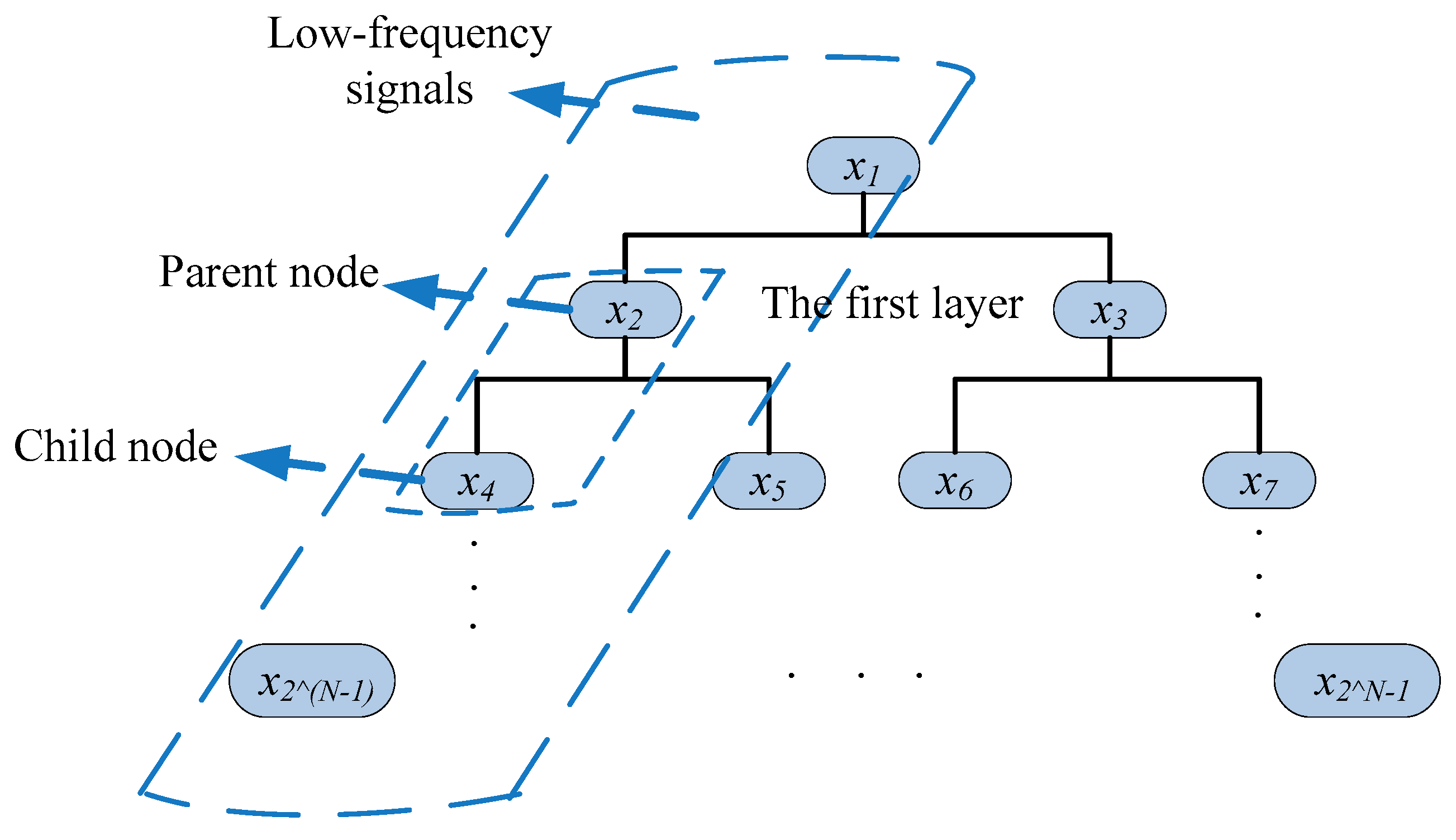
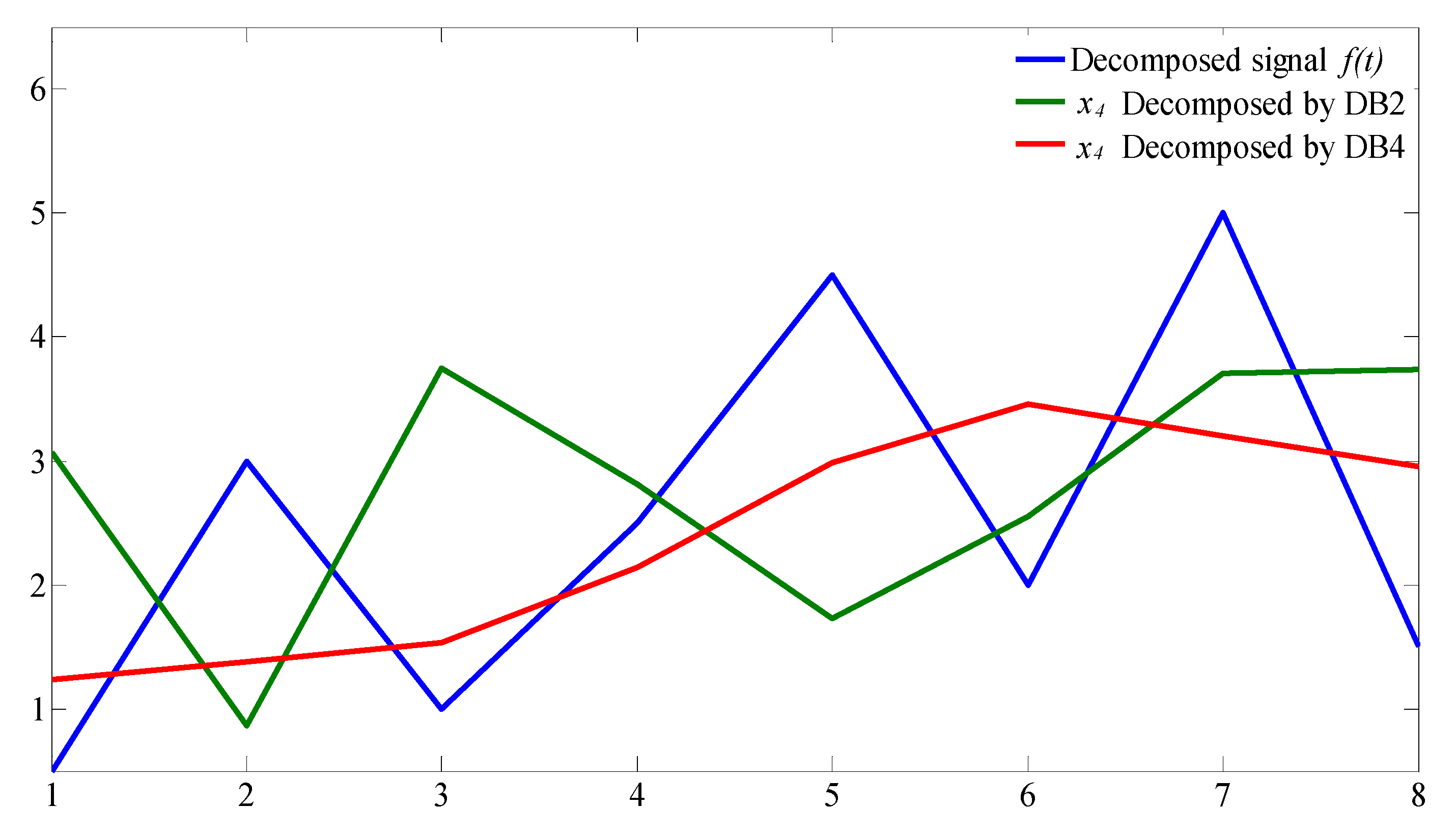
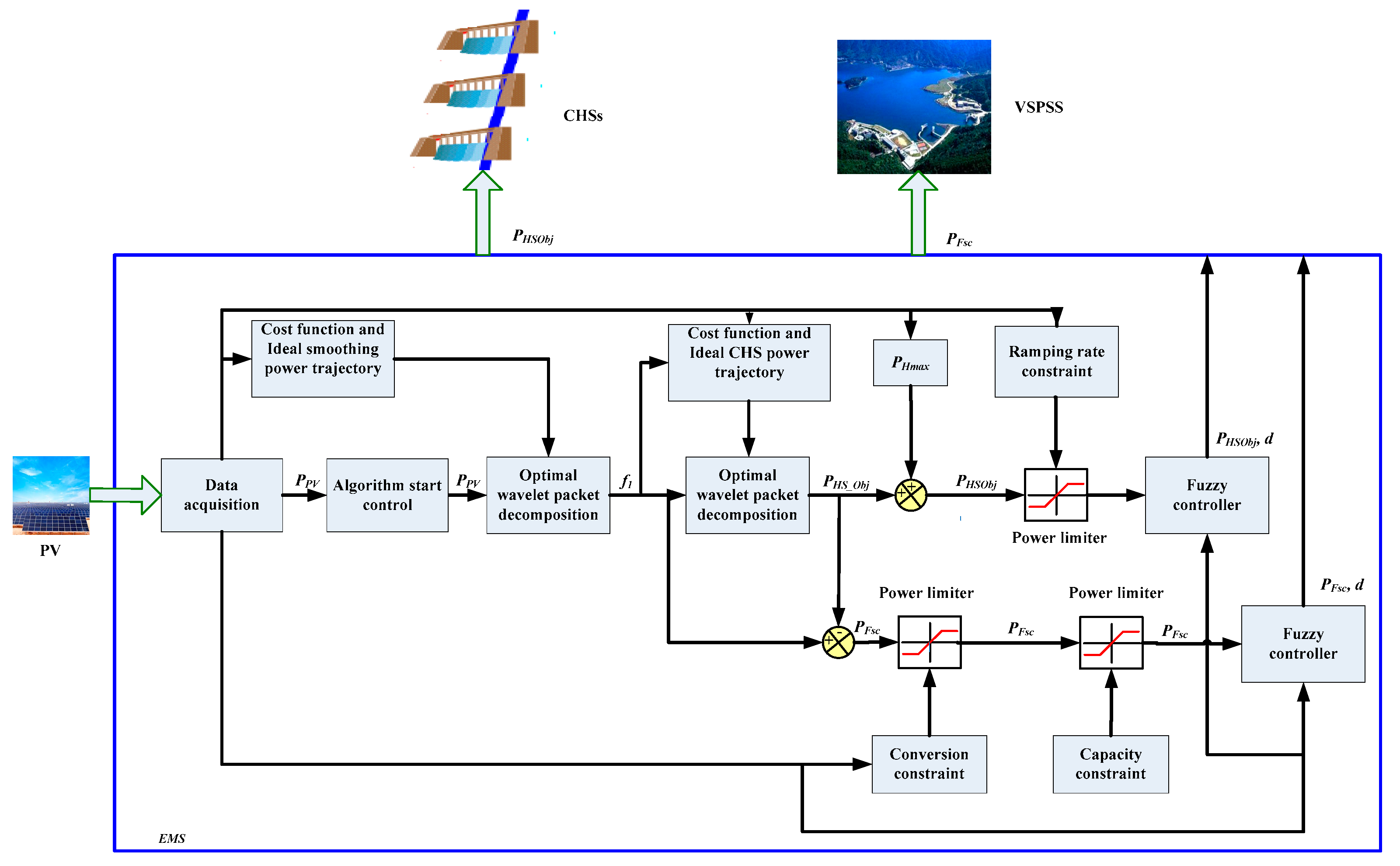

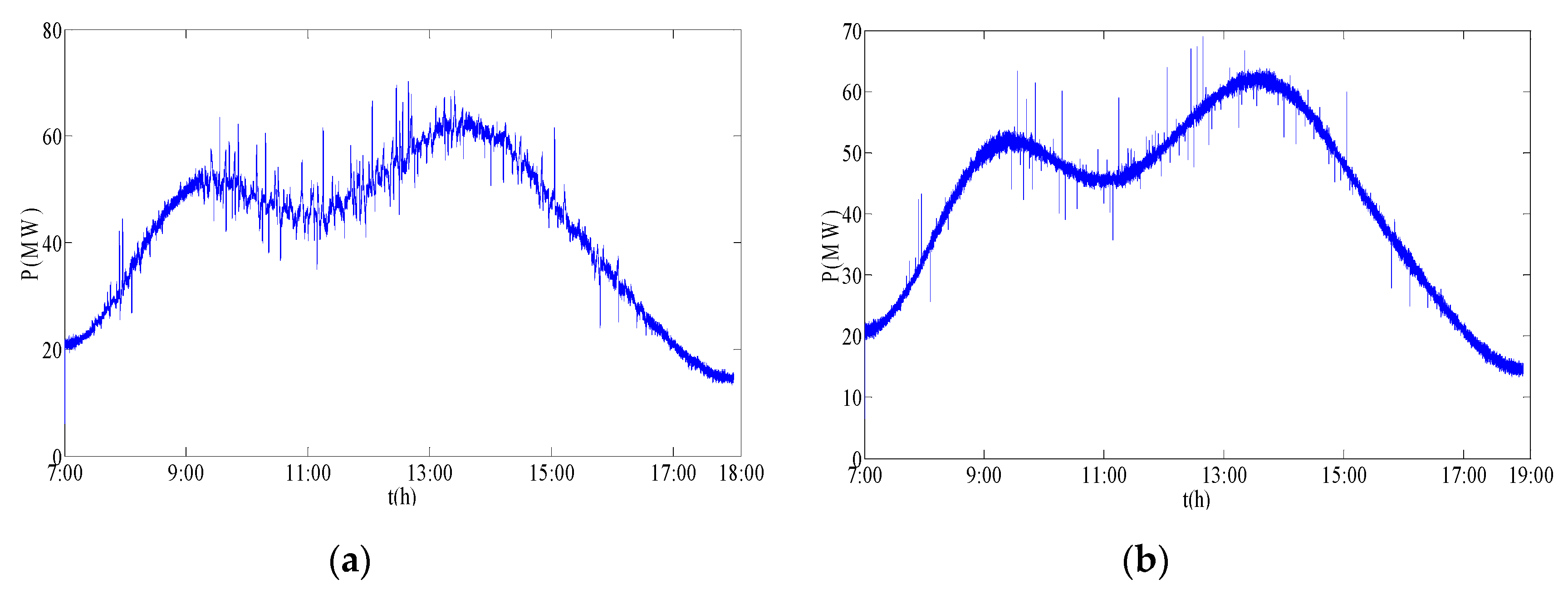


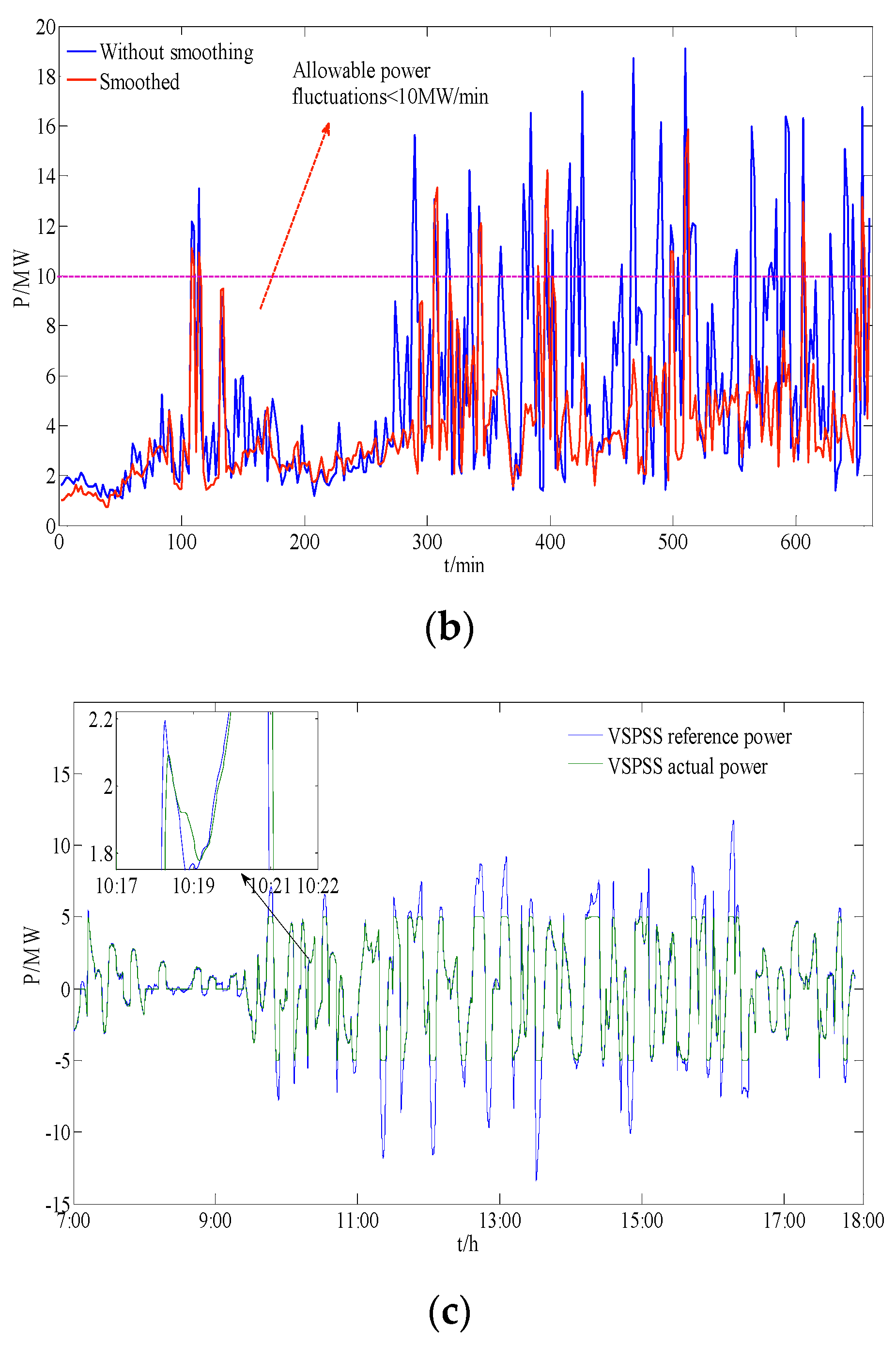

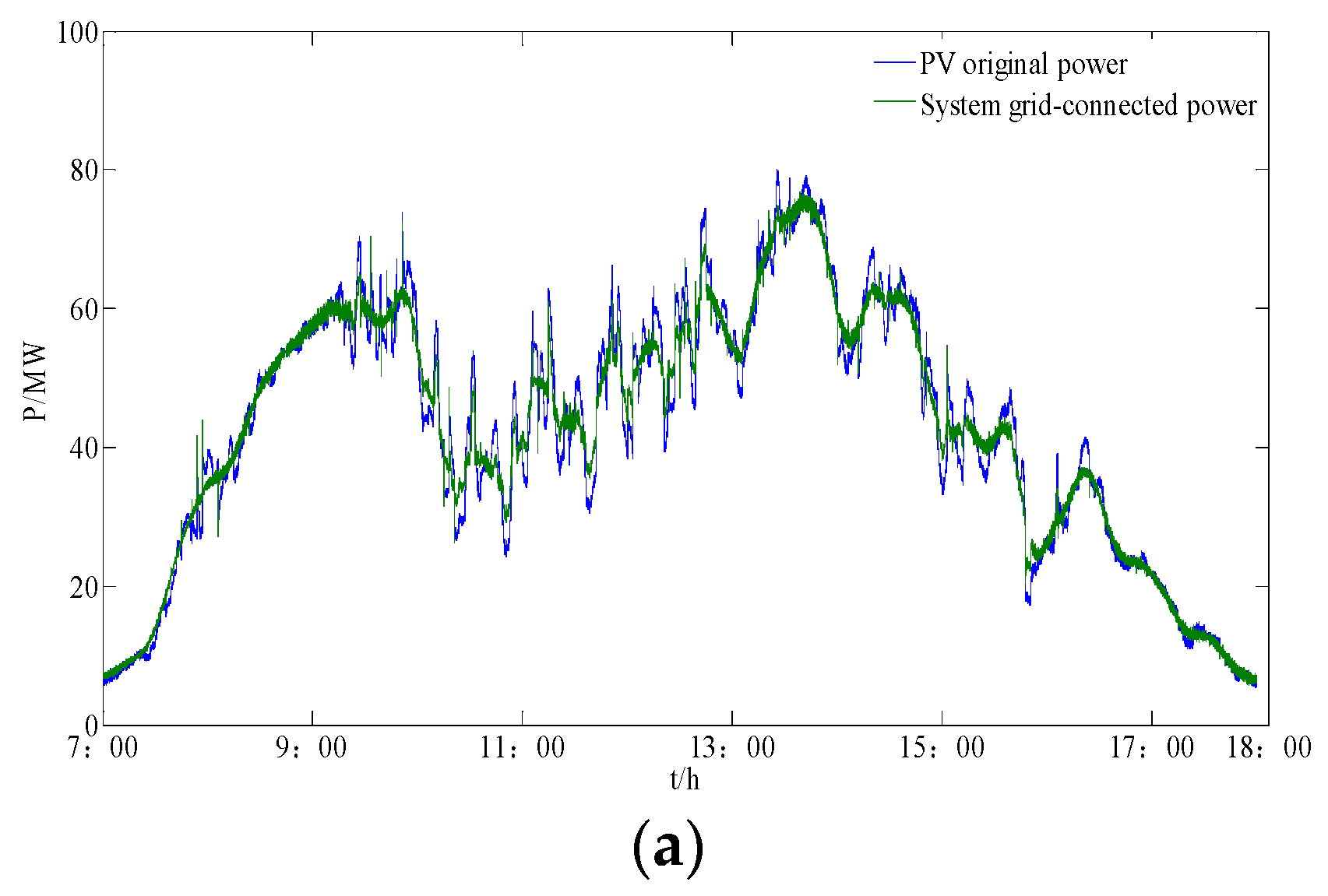
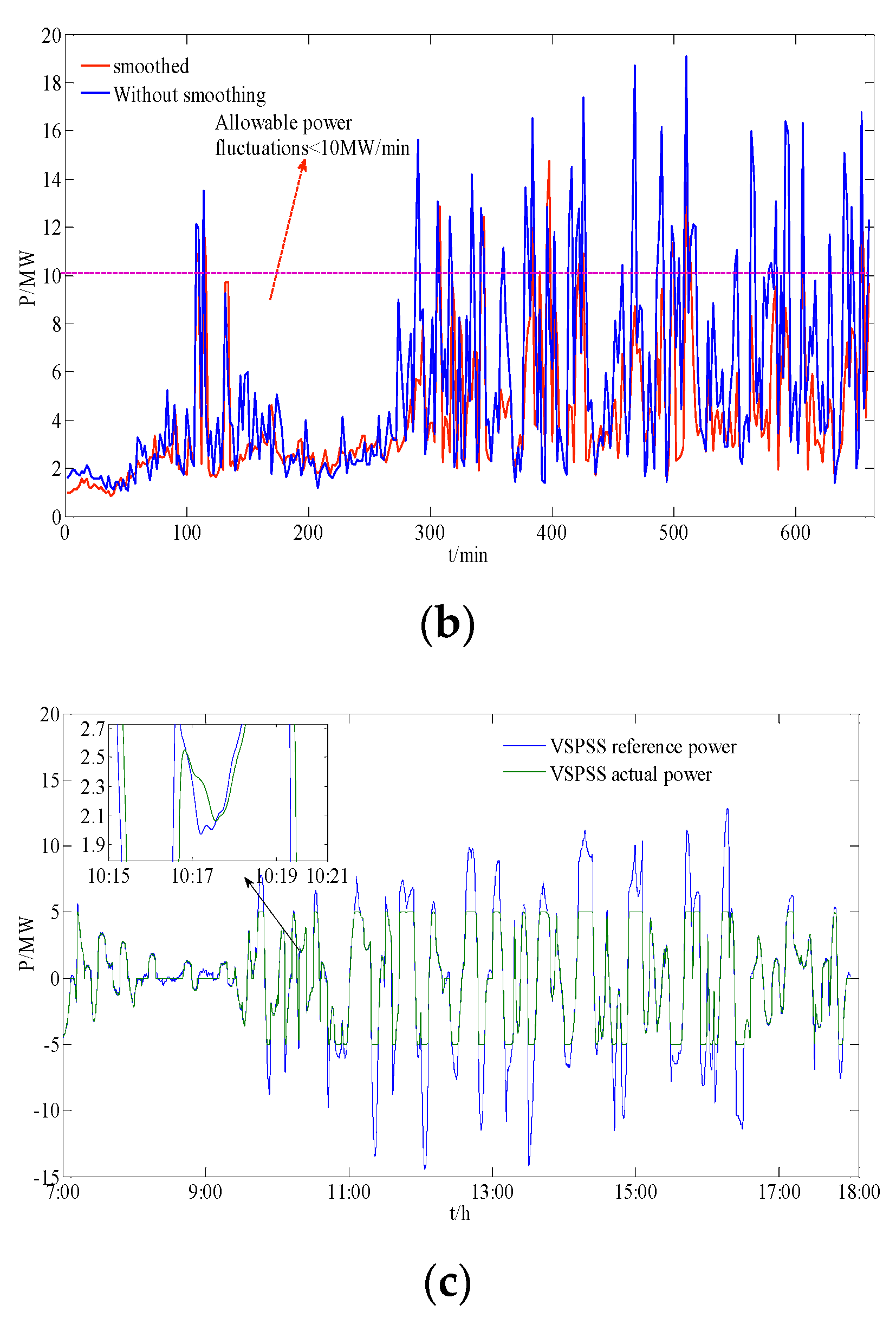

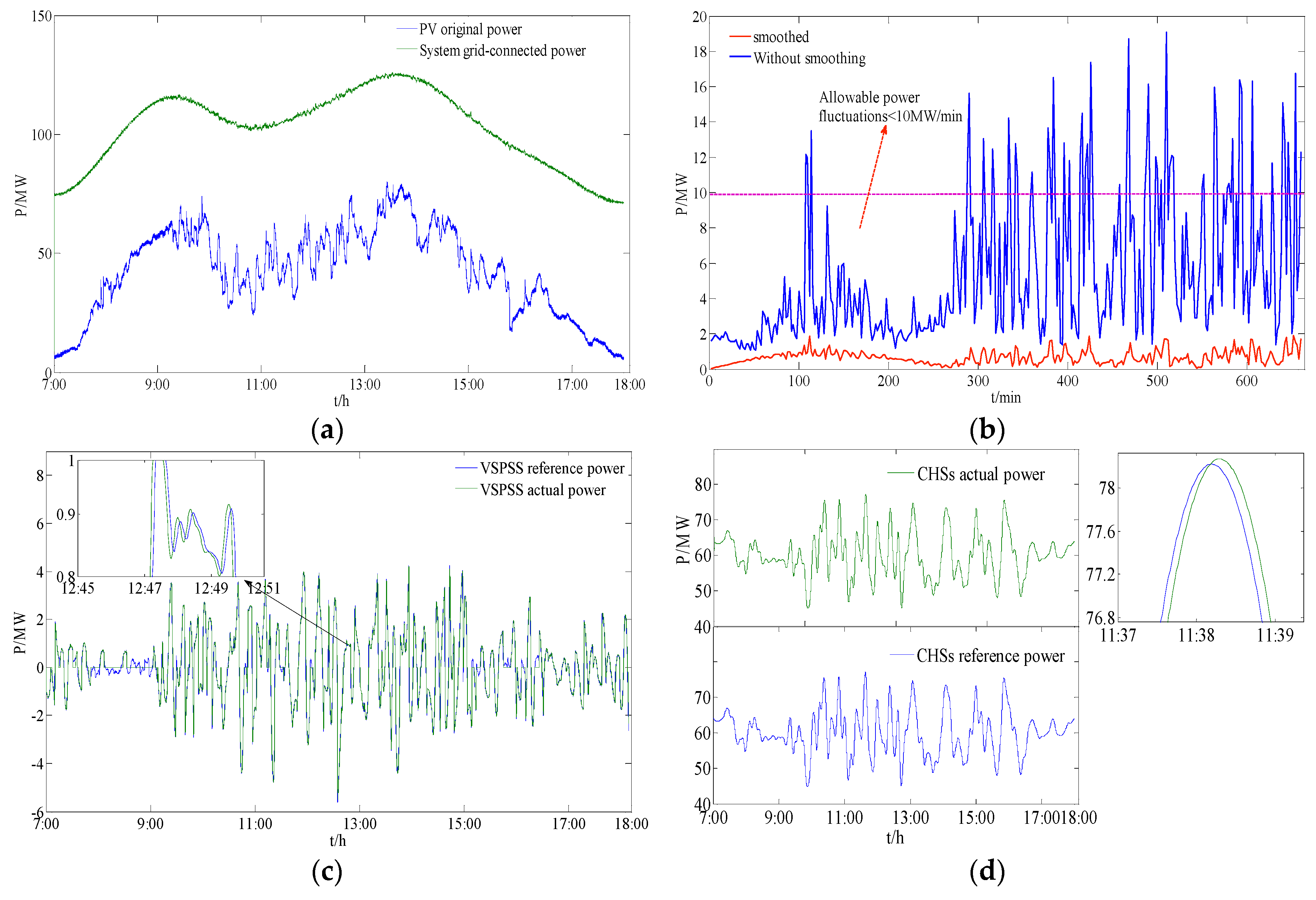
| Smoothing System | Advantages | Disadvantages |
|---|---|---|
| Hybrid energy storage battery | Excellent smoothing effects | Short service life, high maintenance cost, not friendly to the environment |
| Controllable loads | Flexible operation, high economic effect | The smoothing effect is heavily influenced by load requirements |
| Variable speed pumped storage station | Clean energy, high control accuracy, quick response | Small capacity, expensive, inefficient |
| Cascade hydropower stations | Clean energy, large capacity, high economic effect | Poor smoothing effect, slow response, low control accuracy |
| {F0 | F1 | F2 | F3 | F4 | F5 | F6 | F7}x1 |
| {S0 | S1 | S2 | S3}x2 | {D0 | D1 | D2 | D3}x3 |
| {SS0 | SS1}x4 | {DS0 | DS1}x5 | {SD0 | SD1}x6 | {DD0 | DD1}x7 |
| d | epc | ||||||
|---|---|---|---|---|---|---|---|
| ep | VVS | VS | S | M | B | VB | |
| VVS | VB | B | M | S | VS | VS | |
| VS | VB | B | M | S | VS | VVS | |
| S | VB | B | M | VS | VS | VVS | |
| M | VB | M | M | S | VS | VVS | |
| B | VB | M | S | S | VS | VVS | |
| VB | B | M | S | S | VVS | VVS | |
| Method | Failure to Reach Requirements (%) | Maximum Fluctuation (MW) | Average Fluctuation (MW) | Accumulative Error of VSPS (MW) | Accumulative Error of CHSs (MW) |
|---|---|---|---|---|---|
| BS 1 | 24.8 | 19.08 | 10.34 | - | - |
| FA WO 2 CHSs | 12.12 | 15.41 | 5.34 | 35.75 | - |
| WPDA WO CHSs | 11.8 | 14.73 | 4.10 | 47.93 | - |
| FA | 9.39 | 15.87 | 4.02 | 24.09 | 8.21 |
| WPDA | 7.27 | 12.79 | 3.64 | 0.98 | 10.64 |
| OWPDA | 0.3 | 1.9 | 0.67 | 1.17 | 2.38 |
© 2019 by the authors. Licensee MDPI, Basel, Switzerland. This article is an open access article distributed under the terms and conditions of the Creative Commons Attribution (CC BY) license (http://creativecommons.org/licenses/by/4.0/).
Share and Cite
Wu, F.; Wang, J.; Sun, Z.; Wang, T.; Chen, L.; Han, X. An Optimal Wavelet Packets Basis Method for Cascade Hydro-PV-Pumped Storage Generation Systems to Smooth Photovoltaic Power Fluctuations. Energies 2019, 12, 4642. https://doi.org/10.3390/en12244642
Wu F, Wang J, Sun Z, Wang T, Chen L, Han X. An Optimal Wavelet Packets Basis Method for Cascade Hydro-PV-Pumped Storage Generation Systems to Smooth Photovoltaic Power Fluctuations. Energies. 2019; 12(24):4642. https://doi.org/10.3390/en12244642
Chicago/Turabian StyleWu, Fan, Jun Wang, Zhang Sun, Tao Wang, Lei Chen, and Xiaoyan Han. 2019. "An Optimal Wavelet Packets Basis Method for Cascade Hydro-PV-Pumped Storage Generation Systems to Smooth Photovoltaic Power Fluctuations" Energies 12, no. 24: 4642. https://doi.org/10.3390/en12244642






